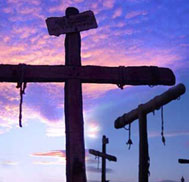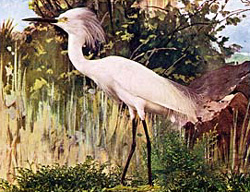MEMO TO THE NEW (THIS) MILLENNIUM
CAPITALISM'S GOLGOTHA (WHERE ALL THAT IS SOLID WASTE MELTS INTO THE LANDSCAPE)
A rhetorical question (stunned silence is the only answer): What does it say about a society that can offer only spent, toxic, post-industrial wasteland for new public urban open space (parks) and, at the same time, seeks to exploit the last truly public lands (wildlife reserves and national parks) for private and commercial gain?
 FRESH KILLS: THE END GAME(S)
FRESH KILLS: THE END GAME(S)New York, New York - Personally, I would have preferred a giant mausoleum (a necropolis) but, alas, I could not enter the Fresh Kills Landscape to Landfill to Landscape Design Competition as I was (in the interest of full disclosure) a 'consultant' from the very beginning of the REAL competition -- i.e., the announcement of the Request For Proposals.
As a mausoleum, Fresh Kills would reverse that age-old axiom "You can't take it with you". The motto for the monstrous landfill cum mausoleum would be "You CAN take it with you". You, now, CAN be buried with all your possessions (past and present), like some ancient potentate or, perhaps, like victims of innumerable contemporary outrages around the world -- those unfortunate souls vaporized in situ (along with their personal property) ...
 Yes, there is a dark side to Fresh Kills, even before the WTC came crashing down on September 11, 2001, and its name only underscores the hyper-nature of the real site versus its projected image as a benign, 'bucolic' estuarine parkland. Being so close to this competition, I cannot really write ABOUT it (despite the evidence you have before your eyes) but AROUND it -- e.g., Fresh Kills: A Tragedy in Three Acts, a mock Shakespearean drama (the dramaturge traumatized by its very writing) suggesting the murk and mire of the whole dizzying affair.
Yes, there is a dark side to Fresh Kills, even before the WTC came crashing down on September 11, 2001, and its name only underscores the hyper-nature of the real site versus its projected image as a benign, 'bucolic' estuarine parkland. Being so close to this competition, I cannot really write ABOUT it (despite the evidence you have before your eyes) but AROUND it -- e.g., Fresh Kills: A Tragedy in Three Acts, a mock Shakespearean drama (the dramaturge traumatized by its very writing) suggesting the murk and mire of the whole dizzying affair.The shadow of Parc Downsview Park fell over the early phases of this process and its traces are still evident in the finalist schemes. Several of the teams were also involved in the 1999 Toronto competition and several of the final proposals include very similar attitudes and fashionable biases as the Downsview projects. These might best be encapsulated under the rubric "Instrumentality" -- which translates roughly as "We are NOT sentimentalists", or "We are NOT Landscape Arcadians" (i.e., acorn-eaters). In fact, the best schemes here negotiate that very high-rhetorical gambit through a masterful inversion of its pretensions -- viz., they reproduce, without batting an eye, the very terminologies denounced by the particular and mischievous process-driven paradigm that IS, after all is said and done, a passing fancy, albeit a very powerful, pseudo-objective flirtation with Deleuzian (Derridean) differance predicated on appropriations from post-structuralism, systems theory, and radical geography (and transmogrified into ever-so-lovely 'neo-picturesque' recreational landscapes via computer generated photomontage). Hence the vision of a more grave Fresh Kills -- The Fresh Kills Mausoleum and Pleasure Grounds.
 This potential (but averted) grave hyper-naturalism shows up in a few of the schemes only as a fugitive essence -- an underlying preternatural instinct or a repressed Je ne sais quoi. The illuminated (Plexiglas) models of several finalists present the uncanny in a form safely AT A DISTANCE from the actual material presented -- an unspoken 'representational' surplus. The ominous glowing landforms or the rivetting illuminated waterways of the models suggest a subterranean (unconscious) apparitional aspect that will NEVER come forth in the actual physical site (except 'by accident'). These models are a prescient representation of the ghosts of the site -- the rubbish under the giganto mounds and the unofficial, toxic effluent lurking in the backwaters of the 2200-acre site (a wetland, after all). This eery otherwordliness will only ever come to be seen in the imagination of those keen enough to see through the site (the surface) and beyond to the ethical graveyard of the entire premise of Fresh Kills (established in the environmentally naive 1940s). The models are superb depictions of the Other of the Actual -- the Hyper-Actual -- or, pseudo-psycho-tragic depictions of the deeper exigencies of a site horribly denatured and marginally 'inhabitable' (by human and/or 'wild' life). What is missing from the models is a showdown between heroic Department of Sanitation action figures and mutant-cyborg anarchists on ATVs. (The beauty of most of these proposals is precisely that there is no authorized reading of the artifacts presented and you, dear reader, may project your own subjectivity into the elastic, flexible contours of the various vision plans.)
This potential (but averted) grave hyper-naturalism shows up in a few of the schemes only as a fugitive essence -- an underlying preternatural instinct or a repressed Je ne sais quoi. The illuminated (Plexiglas) models of several finalists present the uncanny in a form safely AT A DISTANCE from the actual material presented -- an unspoken 'representational' surplus. The ominous glowing landforms or the rivetting illuminated waterways of the models suggest a subterranean (unconscious) apparitional aspect that will NEVER come forth in the actual physical site (except 'by accident'). These models are a prescient representation of the ghosts of the site -- the rubbish under the giganto mounds and the unofficial, toxic effluent lurking in the backwaters of the 2200-acre site (a wetland, after all). This eery otherwordliness will only ever come to be seen in the imagination of those keen enough to see through the site (the surface) and beyond to the ethical graveyard of the entire premise of Fresh Kills (established in the environmentally naive 1940s). The models are superb depictions of the Other of the Actual -- the Hyper-Actual -- or, pseudo-psycho-tragic depictions of the deeper exigencies of a site horribly denatured and marginally 'inhabitable' (by human and/or 'wild' life). What is missing from the models is a showdown between heroic Department of Sanitation action figures and mutant-cyborg anarchists on ATVs. (The beauty of most of these proposals is precisely that there is no authorized reading of the artifacts presented and you, dear reader, may project your own subjectivity into the elastic, flexible contours of the various vision plans.)The Sacred Isle of Meadows is the perfect embodiment of the duplicity of the planning strategy. It is a speck of land at the confluence of the brackish Richmond Creek and the tidal waters between Staten Island and New Jersey and a renowned heron pit stop on the Atlantic Flyway -- a nesting ground in other words for some very lovely birds. It is surrounded by goop, post-industrial wreckage and worshipped by some as a sign of the past AND things to come. It is THE place, therefore, to register some of the more abstruse expectations for post-closure Fresh Kills. The Isle might fall within this NEW Fresh Kills as the spectre of naturalism, but also as a cracked mirror of super-naturalism. This possible Camelot (the new Fresh Kills Park) will then have its strategic looking glass in a downstream 'Island of Shalott' and its 'Ladies of Shalott' in the form of a heron rookery -- i.e., an idyll frequented by photogenic, long-legged migratory birds. One only hopes they don't one day come floating up Richmond Creek ... expired ... sell-by date passed ... a spectacle for the roller-blading public and a chin-stroking conundrum for the site's most astute stewards, the ever-entertaining deep ecologists.
 "Lying, robed in snowy white
"Lying, robed in snowy whiteThat loosely flew to left and right --
The leaves upon her falling light --
Thro' the noises of the night,
She floated down to Camelot"
The Lady of Shalott, Alfred Lord Tennyson
Gavin Keeney (December 2001)
A version of this essay appeared in Competitions (Summer 2002) with critiques of the six finalist plans for the Fresh Kills master plan competition. / The FK master plan was awarded to a design team led by Field Operations (New York, New York) ... / For current details of the FO 'Lifescape' plan, cliquez ici ...
PLEASE NOTE: A model of the Field Operations master plan for Fresh Kills was included in the 2005 MoMA exhibition "Groundswell" ... / For a critique of this exhibition, cliquez ici (RTF) ...
SELECT OUTTAKES
 CAPITALISM'S GOLGOTHA - Fresh Kills End Use Master Plan Competition - Closure (The New York Times, 03/18/01) - Plus! New York City's Department of Sanitation or "New York's Strongest" - And, The Trust for Public Land's Report on Staten Island Open Space - Plus, Fresh Kills and WTC Rubble (The New York Times, 10/21/01) - The latest, Fresh Kills (As Real Estate) (The New York Times, 10/28/01) - 11,000 Tons of Rubbish Per Day (The New York Times, 02/28/02) ...
CAPITALISM'S GOLGOTHA - Fresh Kills End Use Master Plan Competition - Closure (The New York Times, 03/18/01) - Plus! New York City's Department of Sanitation or "New York's Strongest" - And, The Trust for Public Land's Report on Staten Island Open Space - Plus, Fresh Kills and WTC Rubble (The New York Times, 10/21/01) - The latest, Fresh Kills (As Real Estate) (The New York Times, 10/28/01) - 11,000 Tons of Rubbish Per Day (The New York Times, 02/28/02) ...As of 12/07/01 the six finalists' schemes were posted to the FK Competition Web site (URL above) ...
Aerial View of Western Staten Island (PDF / The Trust for Public Land) ...
Raoul Vaneigem's The Book of Pleasures - "Illicit pleasures are banned until they become profitable. Capitalism's need to expand has transformed the world into one gigantic market in which every one of life's myriad manifestations is reduced to just another sales pitch. In so doing, capitalism grows but digs its own grave by killing off the producers who make the expansion possible."